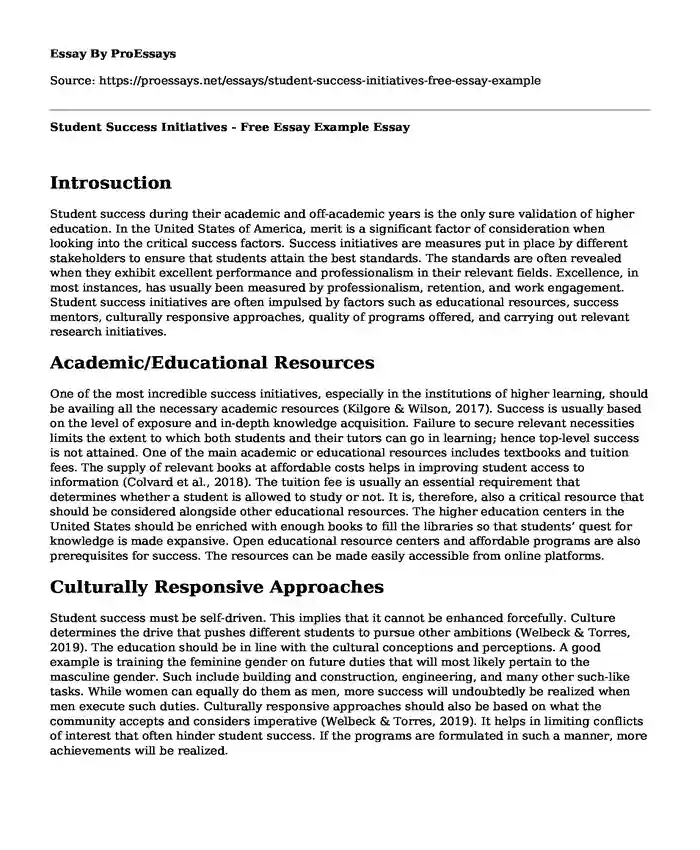Introsuction
Student success during their academic and off-academic years is the only sure validation of higher education. In the United States of America, merit is a significant factor of consideration when looking into the critical success factors. Success initiatives are measures put in place by different stakeholders to ensure that students attain the best standards. The standards are often revealed when they exhibit excellent performance and professionalism in their relevant fields. Excellence, in most instances, has usually been measured by professionalism, retention, and work engagement. Student success initiatives are often impulsed by factors such as educational resources, success mentors, culturally responsive approaches, quality of programs offered, and carrying out relevant research initiatives.
Academic/Educational Resources
One of the most incredible success initiatives, especially in the institutions of higher learning, should be availing all the necessary academic resources (Kilgore & Wilson, 2017). Success is usually based on the level of exposure and in-depth knowledge acquisition. Failure to secure relevant necessities limits the extent to which both students and their tutors can go in learning; hence top-level success is not attained. One of the main academic or educational resources includes textbooks and tuition fees. The supply of relevant books at affordable costs helps in improving student access to information (Colvard et al., 2018). The tuition fee is usually an essential requirement that determines whether a student is allowed to study or not. It is, therefore, also a critical resource that should be considered alongside other educational resources. The higher education centers in the United States should be enriched with enough books to fill the libraries so that students’ quest for knowledge is made expansive. Open educational resource centers and affordable programs are also prerequisites for success. The resources can be made easily accessible from online platforms.
Culturally Responsive Approaches
Student success must be self-driven. This implies that it cannot be enhanced forcefully. Culture determines the drive that pushes different students to pursue other ambitions (Welbeck & Torres, 2019). The education should be in line with the cultural conceptions and perceptions. A good example is training the feminine gender on future duties that will most likely pertain to the masculine gender. Such include building and construction, engineering, and many other such-like tasks. While women can equally do them as men, more success will undoubtedly be realized when men execute such duties. Culturally responsive approaches should also be based on what the community accepts and considers imperative (Welbeck & Torres, 2019). It helps in limiting conflicts of interest that often hinder student success. If the programs are formulated in such a manner, more achievements will be realized.
Research and Quality of Programs Offered
Continuous research is also an element of success. It will require more open resource centers to keep updated with the continuously evolving technology (Salem, 2017). There should be multi-institutional programs such as joint resource centers where students link up with their counterparts from other faculties and share their experiences (Sanders, 2018). Diversity produces a school of thought that is well-versed with future challenges and prepares the students to meet them. Research helps to improve as the technological revolution, and other forms of evolution continue to shape contemporary higher education. In the long run, the quality of education is also enhanced.
Conclusion
Higher education should be geared towards enhancing student success in their respective fields of specialization. Such efforts improve the technical infrastructure of society; hence, the most precious benefits of education are realized. The resources used to train students to determine their level of success. The cultural background and adaptation to the continuously evolving digital world also help in assessing the quality of professionalism in the long run. All the factors should be put together to attain more success among higher education students.
References
Colvard, N. B., Watson, C. E., & Park, H. (2018). The impact of open educational resources on various student success metrics. International Journal of Teaching and Learning in Higher Education, 30(2), 262-276.
Kilgore, W., & Wilson, J. I. (2017). The State of College Completion Initiatives at US Community Colleges. American Association of Collegiate Registrars and Admissions Officers (AACRAO).
Salem, Jr, J. A. (2017). Open pathways to student success: Academic library partnerships for open educational resource and affordable course content creation and adoption. The Journal of Academic Librarianship, 43(1), 34-38.
Sanders, C. G. (2018). Student Success Initiatives that Move the Needle.
Welbeck, R., & Torres, R. (2019). The Male Student Success Initiative: Investing in the Success of Men of Color. MDRC.
Cite this page
Student Success Initiatives - Free Essay Example. (2023, Dec 17). Retrieved from https://proessays.net/essays/student-success-initiatives-free-essay-example
If you are the original author of this essay and no longer wish to have it published on the ProEssays website, please click below to request its removal:
- Analysis of the Biblical Text Essay
- American College of Sports Medicine Paper Example
- Critical Thinking on M. Butterfly and Oleanna Plays
- Research Paper Sample on Unlock Student Potential With Innovative Teaching: A Study of Biology Learning
- Essay Example on Project Management: Techniques to Plan, Estimate, and Control
- Smart Diapers - Free Report Example
- Essay Sample on Electronic Addiction







